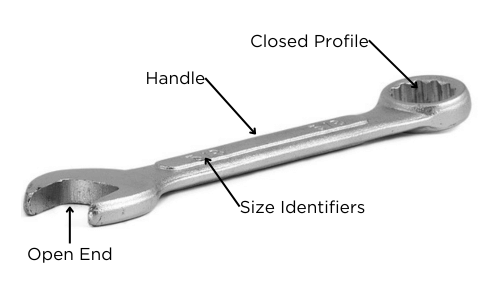Combination Wrench Set (SAE & Metric)
Anatomy of an Combination (Spanner) Wrench

What is a Combination (Spanner) Wrench?
Who would use a Combination (Spanner) Wrench?
Combination wrenches are handy tools for:
- Mechanics and Automotive Technicians: Essential for car and motorcycle maintenance.
- Plumbers: Useful for adjusting pipes and fittings.
- Electricians: Needed for securing electrical components.
- Carpenters and Construction Workers: Helpful for metal framework assembly.
- DIY Enthusiasts: Great for various home repair tasks.
- Bicycle Mechanics: Important for bicycle adjustments and repairs.
- Machinists and Metalworkers: Used in machinery and metalwork.
- Aircraft Technicians: Crucial for airplane and helicopter upkeep.
- HVAC Technicians: Used in the installation and maintenance of HVAC systems.
- Boat and Marine Workers: Necessary for boat and marine equipment maintenance.
- Welders: Used for setting up welding equipment, constructing metal frameworks, and maintaining welding machines.
Safety Precautions with Spanner Wrenches!
When using combination wrenches, it’s important to follow some safety precautions to prevent injury and ensure effective use:
1. Choose the Right Size: Always use a wrench that fits the fastener snugly to avoid slipping and damaging the fastener or injuring yourself.
2. Wear Protective Gear: Depending on the environment, consider wearing safety glasses to protect your eyes from flying debris, and gloves to protect your hands.
3. Inspect the Wrench: Before use, check the wrench for any damage or wear. A damaged wrench can slip or break, leading to injury.
4. Apply Force Correctly: Apply force in a controlled manner, pushing from the open end towards the box end. Avoid pulling towards yourself to reduce the risk of injury if the wrench slips.
5. Avoid Overexertion: Don’t use excessive force or extend the length of the wrench with pipes or other levers for more leverage, as this can over-torque the fastener or break the wrench.
6. Keep a Firm Grip: Ensure your hands are clean and dry to maintain a firm grip on the wrench.
7. Position Yourself Safely: Make sure you have a stable stance and that your body is positioned away from the path of the wrench in case it slips.
8. Use the Right Type for the Job: The open end is useful for quick, less precise work, while the box end provides more secure grip and torque for tighter fasteners.
9. Keep Your Work Area Clean: A cluttered area can lead to accidents. Make sure your workspace is organized and clean.
10. Store Wrenches Properly: When not in use, store your wrenches in a tool box or rack to prevent damage and reduce the risk of accidents.
Following these precautions will help you use combination wrenches safely and effectively, minimizing the risk of injury and damage to the tools or workpieces.
ToolFinder Recommends

CRAFTSMAN Wrench Set, SAE / Metric, 32-Piece (CMMT12080)
A nice wrench set can come at a high cost, but it’s important to have the right wrench size for the right moment when you need it and not have to piece-meal a set together. Using Adjustable Wrenches is not proper for all scenarios either, as they often don’t have the fit/reach for proper torque in certain applications. A reasonable priced set up to 1-1/8″ / 22mm is CRAFTSMAN Wrench Set, SAE / Metric, 32-Piece (CMMT12080)